When I was first starting to learn Japanese back in the 90s, one thing I always hoped to figure out was what some of the Japanese signs in Street Fighter II said. Now that I do know Japanese, I can go back and answer that question… so let’s do that.
E. Honda’s Stage
You know, there actually aren’t that many Japanese signs in Street Fighter II – I thought there were a lot but I guess my memories fooled me. But first up is stuff from E. Honda’s stage.
 |
On the far left of the stage is some Japanese calligraphy-looking thing hanging on the wall. It’s just one Japanese kana character: ゆ. It’s written in English as yu and pronounced like the “yoo” in “yoohoo”.
Rather than try to explain all the confusing details, basically yu by itself means “hot water”, and it’s often used to refer to hot baths or hot springs too. This fits perfectly with E. Honda’s stage, which is some sort of big bath house or something.
Anyway, moving on, there’s also one other piece of Japanese text that appears when a match is over. Some old Japanese painting starts to animate in the background, with some guy holding up some sort of sign:
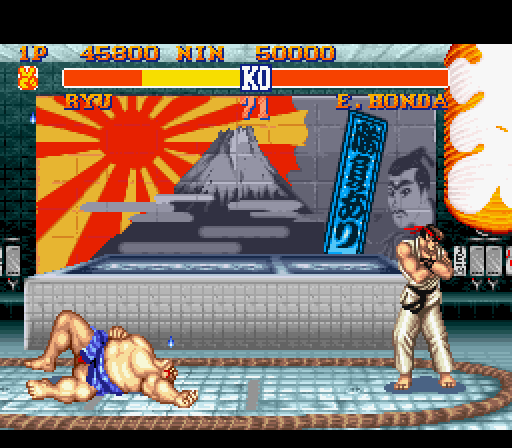 |
When I was first studying the language I was like, “There is NO way anyone can read anything there.” But nope, it very clearly says 勝負あり, which is a standard competition phrase which roughly means something like, “match decided” or “contest over”.
The paper lanterns hanging from the ceiling also have Japanese text on them – they’re very stylized versions of 大入, which is short for 大入り, which means something like “packed audience” or “full house”. It’s used on all sorts of really Japanese stuff in real life:


Ryu’s Stage
A while back I posted an article about how to pronounce Ryu’s name, and now it’s time to take a look at his stage:
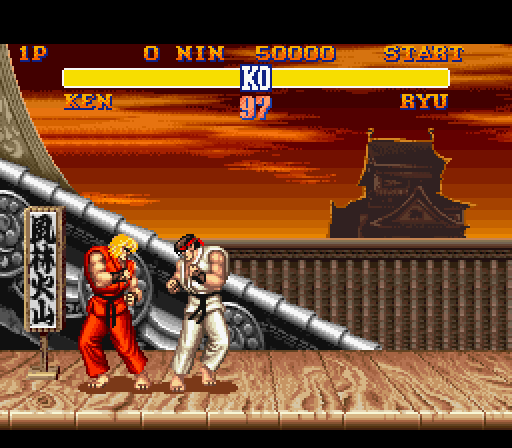 |
On this stage there are two signs that say 風林火山. In Japanese, this is pronounced something like “fooh-reen-kah-zahn”. It literally means “wind, forest, fire, mountain” and is based on Sun Tzu’s “The Art of War”:
Move as swift as a wind, stay as silent as forest, attack as fierce as fire, undefeatable defense like a mountain.
The phrase was also written on war flags used back in the old samurai days. For some more info and details, see this Wikipedia article.
Chun-Li’s Stage
There’s a lot of stuff in Chun-Li’s stage too:
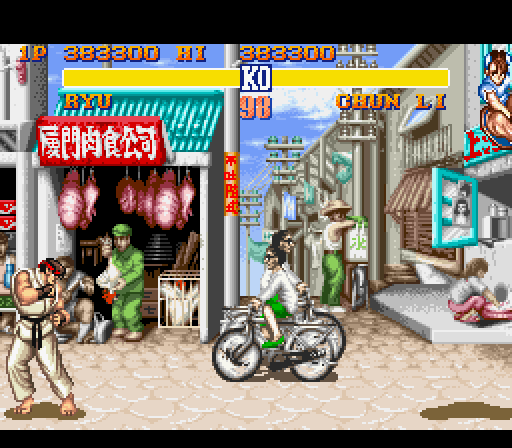 | 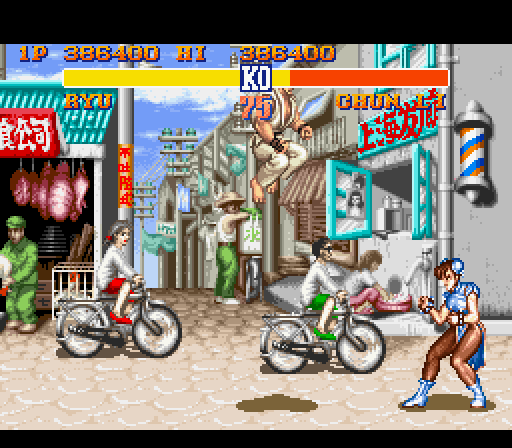 |
Although it might look a lot like Ryu’s text up above, this text is Chinese. Long, long ago, the Japanese language adopted Chinese writing for its own purposes, so a lot of Japanese text might look like Chinese text, but it’s not quite the same. That said, if you know Japanese kanji you can still make out bits and pieces of Chinese writing, kind of like if you only know English you can probably still make out bits and pieces of Spanish text.
So from the above screenshots I see the chicken guy’s sign says something about meat and food. I’m guessing the pole next to it says something about not spitting or something like that? It looks like the green pants guy in the center of the stage is leaning against a sign that might say “ice”. And the sign on the far right says something about Shanghai?
I forgot most of the Chinese I studied back in school, so Chinese-knowing people, let me know what’s up.
Other Stages
Naturally, since you can fight in places all over the world there are lots of other stages that have stuff written in the local language. I’m sure there’s a fan site somewhere that catalogues these things, but since I’m primarily a Japanese-to-English translator I thought I’d just share what little insight I can personally offer. But if anyone out there has any more insight or helpful links, let me know in the comments.



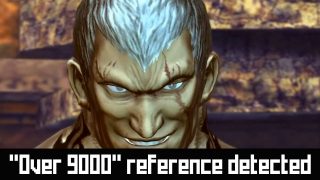


The Katamari Damacy games have loads of Japanese writing all over. In the shopping mall level on the Xbox 360 game, there’s bajillions of text everywhere on the walls and on the products themselves. It’s awesome and I love ignoring the level objective just trying to read it all.
In Pokémon Ruby and Sapphire, each room of Norman’s gym of Normal-type Pokémon has some text on a scroll on the back of the walls, but it’s just too pixelly for me to make out. It’s the same sprite each time though, so it might just be decoration.
The Famicom game “Getsu Fuuma Den” has not a lick of Latin alphabet anywhere at all in it other than for the word “Konami” on the title screen. Even your passwords are given to you in hiragana! It’s too bad the game is a boring Zelda II clone, because otherwise I would be really into it.
Kirby Super Star has the Ninja minigame which is has some Japanese text in it. Maybe there’s more in that game too but I can’t remember at the moment.
In Tales of Xillia, the icons for elemental damage (fire, wind, water, earth, light, dark) vaguely resemble the kanji for each…but that’s not quite the same thing.
Excuse you, Getsu Fuuma Den is a /very interesting/ combination of Zelda II, Castlevania, and even Wizardry! 😛
The World Ends With You. That one DS game that takes place in modern day Shibuya. You don’t have to play very far to see a ton of Japanese signage. Although I’m pretty sure none of it is interesting.
If you have any screenshots of stuff in particular I can take a look at them for you. I’ve never played the game myself :X
I’ve always wondered if the various “symbols” that appear on the Monado in Xenoblade have actual meaning in Japanese. It’s not quite a sign, but it’s close!
Yeah, those are definitely all kanji, though they’re stylized and a bit hard to make out. I think they roughly correspond to what each move does – for instance, the one for the move Shield is the kanji meaning “shield”.
Been a fan of this site for awhile now. I’d like to request that when you write or explain kanji, could you also write the equivalent kana? A few of us (well, me at least) know enough Japanese to speak, and to read kana, but don’t know much kanji. It is a bit frustrating to just be given kanji and English, with no middle ground! It’s fun to pick up new things.
Thanks, keep up the good work! 🙂
Sure thing, I’ll probably make a post about it sometime to have as a reference that I can point to in future stuff I write. I usually just link to Wikipedia whenever mentioning kana or kanji, but an actual post would probably help a lot more now that I think about it.
I also think the first two kanji on the blue sign in Chun Li’s stage starts are “Shanghai”, which I only realized after playing a bit of the Super Famicom versions of that puzzle game.
And E. Honda’s stage… gotta love the Peter Griffin vs. Mr. Washee-washee fight. 😀
(only missing the part about pushing a button to make the sun flash faster)
Yeah, someone on Twitter pointed out that the hanzi say something like Shanghai Barber.
And oh crap is that really true about making the sun flash faster? If so I never ever knew about that 😯
Shanghai that mahjong solitaire I’ve played too! Great game.
Hey now, Furin Kazan, now I remember! It’s one of the four-character EX special attacks in Cross Edge. The characters each take an element and say those lines. 😀
By the way, have you been getting my friend’s emails? He’s sent you a couple and hasn’t heard from you.
Which friend? I usually take a pretty long time to respond to e-mails that I want to give thoughtful replies to (current backlog is like 70 aaaaaaaa) but Twitter is a much better way to get my attention if it’s for something simple.
He sent this email:
I’ve been curious about this mystery message you can find in Sonic CD: http://www.vgfacts.com/trivia/719/
Now, from my understanding, this is apparently either a pun on the similar sound between Madjin and majin (魔神) or because “Madjin” is a nickname for Masato Nishimura. Is this just some clever pun?
I remembered when I learned about the sign on Ryu’s stage but not because of studies but because of NHK’s Taiga Drama, Furin Kazan (https://www.youtube.com/watch?v=Bw53-auCi4s), that aired here in Los Angeles. Then one day I played SFII somewhere and I saw those signs and I went “OH CRAP! It’s the Furin Kazan!”
Oops. I gave a wrong link, but you get the idea.
The Chinese on Chun Li’s stage says:
(L) Xiamen Meat Company [Xiamen being a city in Fujian, formerly known as Amoy in English]
(R) Shanghai Barber
The one in the middle I can’t make out the last two characters of, but I know in this version – -http://www.gamesradar.com/the-top-7-fighting-game-backgrounds/?page=4 – it says “No Spitting”
Well,this article was a year ago but I think I can help a bit on the Chinese text.
The sign on the chicken guy’s shop is 廈門肉食公司,廈門(Xiamen) is the name of the company,but is also a major city in China.
(肉食公司) literally mean “Meat Company”.Yet, I don’t think most “Meat company” would just hang their meats in the shop, they usually sell frozen meat and other meat product.
The “ice”(氷) sign may actually is “water”(水)
since there are no shop or place sell ice in China
(and if you are talking about stuff likes ice-creams,you can found it in supermarket and Convenience Store but they never put a big “ice” sign outside of the shop)
and the metal thing under the sign kind of look likes a Faucet to me.
Thirdly, the (上海发廊) sign is actually “Shanghai salon”, written in Chinese Simplified.
And about the pole……no, I don’t know either because It’s make no sense in Chinese
as we normally use 不准吐痰 or 禁止吐痰 for No spitting.The sign was written as 不吐(and the last two words is unreadable).I really think that Capcom mess up about that part.
Hope it’s helpful to you and sorry about all those horrible grammar.
Just came across your site, very interesting! Vega’s (Balrog’s) stage in Spain says in the background “Mesón de la Taberna”, which sounds funny since both are words for pub/inn in Spanish. So it is like saying “The Pub of the pub” or something like that.
I remember one of the ninja in World Heroes had a “tatsumaki sempuu kyaku” kind of attack called “ninpo fuurinkazan” (he even shouts it aloud). Now I am wondering if it is one more nod to their “homage” of Ryu and Ken…
I think Capcom caught that mistake in Vega’s stage — in SFV they changed it to read “Mesón de Las Flores”.